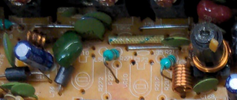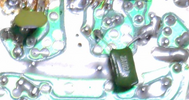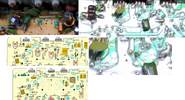The AM Regulator that B754 (B574?) - is a simple transistor - the "audio amp" is the long 9 pin package just towards the front panel but by it. Handles RX and Talkback but all the audio you hear on air is done thru that AM Regulator transistor.
IF the Audio amp gets "hot" that usually tells me the radio has drying out or dried out caps - that chip can run warm, but when in TX it is not "on" unless you have talkback enabled - it's purposely muted so might want to look into this too - see if the "Talkback" feature is permanently disabled - you would see the diode that takes TX power and sends it to the Audio chip - D89 - if that has been cut or otherwise messed with solder side too - another mod that has to be undone.
In the CB Tricks archives TR39 (or TR30) uses a jumper wire - just remove that wire and then retest the radio for temperature and also look into purchasing some caps to help refresh the filter and audio passing sections that Audio amp sends power to thru these caps.
The AM Regulator is the hottest of the three, I was mistaken and thought that was the audio amp. Audio amp sat around 80 and didnt move much when TXing, so it sounds like it was working as expected.
I'm going to start replacing the electrolytic caps since I have most of those on hand. I do not have any disc or chiclet caps.
As for the caps you talked about earlier, for the driver/finals, exactly which caps were you talking about?




